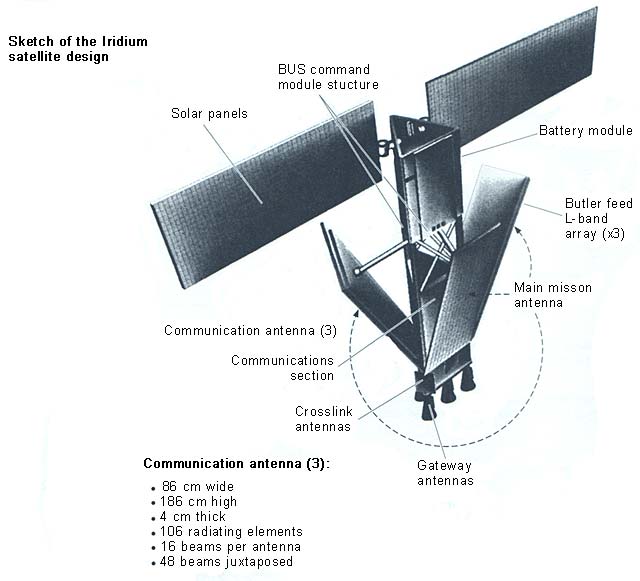
Dear all,
its a sad news for all the people who have interest in satellites. two of our friends namely iridium 33 and cosmos 2251 have collided in space.
In an unprecedented space collision, a commercial Iridium communications satellite (IRIDIUM 33, NORAD ID 24946) and a defunct Russian satellite (COSMOS 2251, NORAD ID 22675) ran into each other on February 10, 2009 above Northern Siberia, creating a cloud of debris. The impact occured at 16:56:00 UTC (11:56:00 AM EST), at Latitude 72° 30' 04'', Longitude 97° 52' 46'', Altitude 788.68 km (490.0 miles). into 600 pieces it can be said that it was not a malfunctioning.Iridium Satellite LLC operates a constellation of some 66 satellites, along with orbital spares, to support satellite telephone operations around the world. The spacecraft, which weigh about 1,485 pounds when fully fueled, are in orbits tilted 86.4 degrees to the equator at an altitude of about 485 miles. Ninety-five Iridium satellites were launched between 1997 and 2002 and several have failed over the years.
Yesterday, Iridium Satellite LLC lost an operational satellite, the company said in a statement. According to information shared with the company by various U.S. government organizations that monitor satellites and other space objects (such as debris), it appears that the satellite loss is the result of a collision with a non-operational Russian satellite.
Although this event has minimal impact on Iridium's service, the company is ta king immediate action to address the loss. The Iridium constellation is healthy, and this event is not the result of a failure on the part of Iridium or its technology. While this is an extremely unusual, very low-probability event, the Iridium constellation is uniquely designed to withstand such an event, and the company is taking the necessary steps to replace the lost satellite with one of its in-orbit spare satellites.
king immediate action to address the loss. The Iridium constellation is healthy, and this event is not the result of a failure on the part of Iridium or its technology. While this is an extremely unusual, very low-probability event, the Iridium constellation is uniquely designed to withstand such an event, and the company is taking the necessary steps to replace the lost satellite with one of its in-orbit spare satellites.
Johnson said the collision was unprecedented.
Nothing to this extent (has happened before), he said. e've had three other accidental collisions between what we call catalog objects, but they were all much smaller than this and always a moderate sized objects and a very small object. And these are two relatively big objects. So this is a first, unfortunately.
As for the threat posed by the debris, Johnson said NASA carried out an immediate analysis to determine whether the space station faced any increased risk. The station, carrying three crew members, circles the globe at an altitude of about 220 miles in an orbit tilted 51.6 degrees to the equator.
Yesterday, Iridium Satellite LLC lost an operational satellite, the company said in a statement. According to information shared with the company by various U.S. government organizations that monitor satellites and other space objects (such as debris), it appears that the satellite loss is the result of a collision with a non-operational Russian satellite.
Although this event has minimal impact on Iridium's service, the company is ta
 king immediate action to address the loss. The Iridium constellation is healthy, and this event is not the result of a failure on the part of Iridium or its technology. While this is an extremely unusual, very low-probability event, the Iridium constellation is uniquely designed to withstand such an event, and the company is taking the necessary steps to replace the lost satellite with one of its in-orbit spare satellites.
king immediate action to address the loss. The Iridium constellation is healthy, and this event is not the result of a failure on the part of Iridium or its technology. While this is an extremely unusual, very low-probability event, the Iridium constellation is uniquely designed to withstand such an event, and the company is taking the necessary steps to replace the lost satellite with one of its in-orbit spare satellites.Johnson said the collision was unprecedented.
Nothing to this extent (has happened before), he said. e've had three other accidental collisions between what we call catalog objects, but they were all much smaller than this and always a moderate sized objects and a very small object. And these are two relatively big objects. So this is a first, unfortunately.
As for the threat posed by the debris, Johnson said NASA carried out an immediate analysis to determine whether the space station faced any increased risk. The station, carrying three crew members, circles the globe at an altitude of about 220 miles in an orbit tilted 51.6 degrees to the equator.
from this as there are air traffice controllers here on earth,there have to be space traffic controller. There are two issues: the immediate threat and a longer-term threat,.It turns out, when you have a collision like this the debris is thrown very energetically both to higher orbits and to lower orbits. So there are actually debris from this event which we believe are going through the space station's altitude already. Most of it is not, most of it is still clustered up where the event took place. But a small number are going through station's altitude.
Most, if not all, of the debris is expected to eventually burn up in Earth's atmosphere